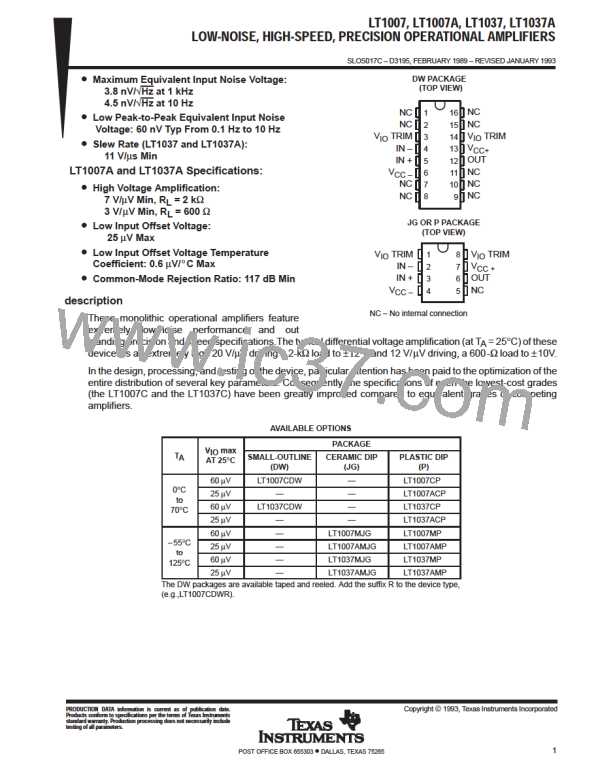LT1007, LT1007A, LT1037, LT1037A
LOW-NOISE, HIGH-SPEED, PRECISION OPERATIONAL AMPLIFIERS
SLOS017C – D3195, FEBRUARY 1989 – REVISED JANUARY 1993
APPLICATION INFORMATION
Special test precautions are required to measure the typical 60-nV peak-to-peak noise performance of the
LT1007 and LT1037:
1. The device should be warmed up for at least five minutes. As the operational amplifier warms up, the offset
voltage typically changes 3 µV, due to the chip temperature increasing 10°C to 20°C from the moment the
power supplies are turned on. In the 10-second measurement interval, these temperature-induced effects
can easily exceed tens of nanovolts.
2. The device must be well shielded from air currents to eliminate thermoelectric effects. In excess of a few
nanovolts, thermoelectric effects would invalidate the measurements.
3. Sudden motion in the vicinity of the device can produce a feedthrough effect that increases observed noise.
When measuring noise on a large number of units, a noise-voltage density test is recommended. A 10-Hz
noise-voltage density measurement will correlate well with a 0.1-Hz to 10-Hz peak-to-peak noise reading since
both results are determined by the white noise and the location of the 1/f corner frequency.
Figure 40 shows a circuit that measures noise current and presents the formula for calculating noise current.
10 kΩ
100 Ω
500 kΩ
500 kΩ
–
+
[vn2
(130 nV)2]1 2
1 M x 100
e
no
In
Figure 40. Noise Test Circuit
The LT1007 and LT1037 achieve low noise, in part, by operating the input stage at 120 µA versus the typical
10 µA for most other operational amplifiers. Voltage noise is directly proportional to the square root of the stage
current; therefore, the LT1007 and LT1037 noise current is relatively high. At low frequencies, the low 1/f
current-noise corner frequency (≈120 Hz) minimizes noise current to some extent.
In most practical applications, however, noise current will not limit system performance; this is illustrated in
Figure 27, where:
2
2
2 1/2
total noise = [(noise voltage) (noise current x R ) + (resistor noise) ]
S
Three regions can be identified as a function of source resistance:
(i)
R
≤ 400 Ω
Voltage noise dominates in region (i)
Resistor noise dominates in region (ii)
S
(ii) R = 400 Ω to 50 kΩ at 1 kHz
S
R = 400 Ω to 8 kΩ at 10 kHz
S
(iii) R > 50 Ω at 1 kHz
Current noise dominates in region (iii)
S
R > 8 kΩ at 10 Hz
S
The LT1007 and LT1037 should not be used in region (iii) where total system noise is at least six times higher
thanthenoisevoltageoftheoperationalamplifier(i.e., thelow-voltagenoisespecificationiscompletelywasted).
19
POST OFFICE BOX 655303 • DALLAS, TEXAS 75265

 TI [ TEXAS INSTRUMENTS ]
TI [ TEXAS INSTRUMENTS ]